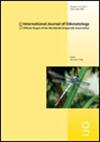中亚豆蝇Calopteryx samarcandica Bartenev的分类地位(蜻蜓目:Calopterygidae)
IF 1
4区 农林科学
Q3 ENTOMOLOGY
引用次数: 0
摘要
利用乌兹别克斯坦东南部库吉唐山的分子和表型资料,确定了中亚豆娘Calopteryx samarcandica的分类地位。分子分析(COI和18S rDNA, ITS1-5.8S rDNA- its2)表明,C. samarcandica是一个分支的一部分,包括文献中作为Calopteryx splendens亚种和/或近缘种的分类群。然而,线粒体和核DNA都证实了C. samarcandica应该获得单独的物种地位。与C. splendens(包括C. xanthostoma)的COI距离中等(3.47%,K2P),但远大于C. splendens合格序列之间的内部距离(0.4%);这种差异是由该属的条形码间隙值较低所支持的。与锦兰(副属、牛头属、中间种)和东方种的距离较远,以及核rDNA中可识别的果树枝的长度,加强了第一种的独立地位。C. samarcandica在Calopteryx属中的系统发育地位尚不清楚,因为其核rDNA标记的可变性较低,而且其他类群的数据不足,部分无法比较。分子数据支持C. samarcandi-ca的表型和生态特异性,通过其特征的诊断组合(雄性和雌性翅膀的颜色,雄性翅膀斑点的大尺寸和基部扩散)以及与广阔的中亚山区和丘陵地区的地下水天然河道的保守联系来定义。本文章由计算机程序翻译,如有差异,请以英文原文为准。
Taxonomic status of the Central Asian damselfly Calopteryx samarcandica Bartenev, 1912 (Odonata: Calopterygidae)
The taxonomic status of the Central Asian damselfly Calopteryx samarcandica was determined on the basis of molecular and phenotypic data from the Kugitang Mountains, SE Uzbekistan. Molecular analyses (COI and 18S rDNA, ITS1-5.8S rDNA-ITS2) revealed that C. samarcandica forms part of a clade that includes taxa treated in the literature as subspecies of Calopteryx splendens and/or related species. However, both mitochondrial and nuclear DNA confirmed that C. samarcandica deserves separate species status. The COI distance to C. splendens (including C. xanthostoma) is moderate (3.47%, K2P), but much greater than the internal distances between the sequences qualified in C. splendens (0.4%); this difference is supported by the low values of the barcoding gap in this genus. The rather distant separation of C. samarcandica from both C. splendens (ancilla, taurica, intermedia) and C. orientalis and the length of the samarcandica-branch recognisable in nuclear rDNA strengthen the independent position of the first species. The phylogenetic position of C. samarcandica in the genus Calopteryx remains unclear due to the low variability of nuclear rDNA markers and insufficient and partly incomparable data for other taxa. The molecular data support the phenotypic and ecological specificity of C. samarcandica, defined by a diagnostic combination of its traits (male and female wing colours and large size and basal diffusion of the wing spot in males) and the conservative association with groundwater-fed natural watercourses in the mountains and foothills fringing the vast Central Asian mountain block.
求助全文
通过发布文献求助,成功后即可免费获取论文全文。
去求助
来源期刊

International Journal of Odonatology
ENTOMOLOGY-
CiteScore
2.30
自引率
0.00%
发文量
15
审稿时长
>12 weeks
期刊介绍:
International Journal of Odonatology (IJO) is aimed at providing a publication outlet for the growing number of students of Odonata. It will address subjects such as the ecology, ethology, physiology, genetics, taxonomy, phylogeny and geographic distribution of species. Reviews will be by invitation, but authors who plan to write a review on a subject of interest to the journal are encouraged to contact the editor.
 求助内容:
求助内容: 应助结果提醒方式:
应助结果提醒方式:


